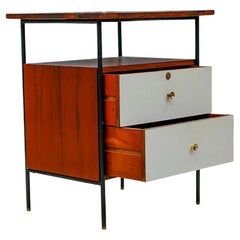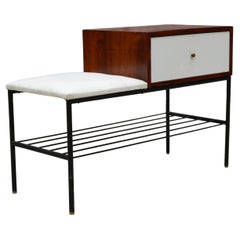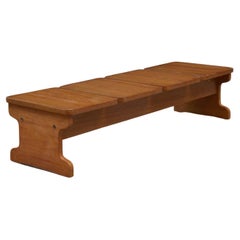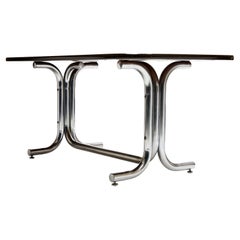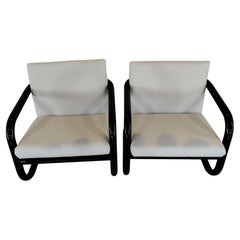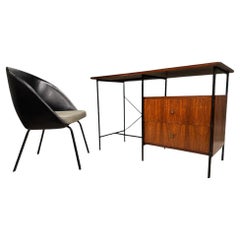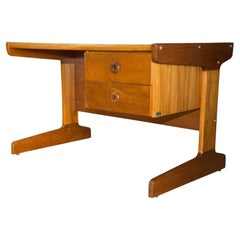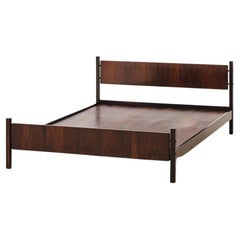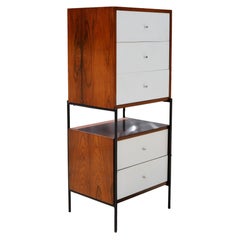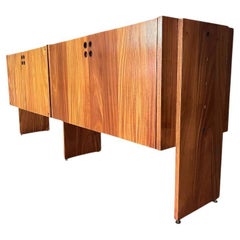Geraldo de Barros On Sale
Mid-20th Century Brazilian Mid-Century Modern Side Tables
Metal
Mid-20th Century Brazilian Mid-Century Modern Armchairs
Hardwood
Mid-20th Century Brazilian Mid-Century Modern Armchairs
Metal
Mid-20th Century Brazilian Mid-Century Modern Benches
Metal
Vintage 1950s Brazilian Mid-Century Modern Carts and Bar Carts
Metal
Mid-20th Century Brazilian Mid-Century Modern Benches
Wood
Mid-20th Century Brazilian Mid-Century Modern Dining Room Tables
Chrome
Vintage 1970s Brazilian Mid-Century Modern Sofas
Metal
Vintage 1970s Brazilian Mid-Century Modern Armchairs
Leather, Wood
Mid-20th Century Brazilian Mid-Century Modern Desks and Writing Tables
Metal
Vintage 1970s Brazilian Mid-Century Modern Desks
Hardwood
Vintage 1950s Brazilian Mid-Century Modern Beds and Bed Frames
Rosewood
Mid-20th Century Brazilian Mid-Century Modern Commodes and Chests of Dra...
Brass
Mid-20th Century Brazilian Mid-Century Modern Cabinets
Formica, Hardwood
Mid-20th Century Brazilian Mid-Century Modern Dining Room Tables
Hardwood
Vintage 1950s South American Mid-Century Modern Shelves and Wall Cabinets
Brass, Iron
Vintage 1970s Brazilian Mid-Century Modern Benches
Wood
Recent Sales
Vintage 1950s Brazilian Mid-Century Modern Cabinets
Iron
Mid-20th Century Brazilian Mid-Century Modern Credenzas
Hardwood
People Also Browsed
Mid-20th Century Brazilian Mid-Century Modern Sofas
Suede, Fiberglass
2010s Italian Modern Chandeliers and Pendants
Metal, Brass
21st Century and Contemporary Swedish Mid-Century Modern Table Lamps
Textile
21st Century and Contemporary Mexican Mid-Century Modern Floor Lamps
Textile, Wood, Linen, Fiberglass
Vintage 1950s Brazilian Mid-Century Modern Coffee and Cocktail Tables
Hardwood
Mid-20th Century Brazilian Mid-Century Modern Chairs
Leather, Hardwood
2010s Italian Modern Chandeliers and Pendants
Brass
Mid-20th Century Brazilian Mid-Century Modern Armchairs
Wood, Cane, Hardwood
21st Century and Contemporary French Mid-Century Modern Sofas
Stainless Steel
Mid-20th Century Brazilian Mid-Century Modern Armchairs
Straw, Hardwood
Mid-20th Century Brazilian Mid-Century Modern Carts and Bar Carts
Steel
Mid-20th Century Brazilian Mid-Century Modern Lounge Chairs
Metal, Iron
Vintage 1960s Brazilian Mid-Century Modern Console Tables
Chrome
Mid-20th Century Brazilian Modern Armchairs
Fabric
Mid-20th Century Brazilian Mid-Century Modern Sofas
Fabric, Hardwood
Vintage 1950s American Mid-Century Modern Dressers
Brass
Geraldo de Barros On Sale For Sale on 1stDibs
How Much is a Geraldo de Barros On Sale?
Geraldo de Barros for sale on 1stDibs
Although best known for his photography, Geraldo de Barros was an important contributor to the canon of mid-century modern furniture design and was one of Brazil’s most influential multidisciplinary artists.
Born in 1923 in Chavantes, São Paulo, de Barros began his artistic career as a painter before discovering a passion for photography in the 1940s. In 1950, he found fame with his successful “Fotoformas” exhibition held at the Museu de Arte de São Paulo, which led to a scholarship from the French government to study in that country.
In the early 1950s, de Barros traveled throughout Europe, including Switzerland, where he met Bauhaus graduate Max Bill. At the time, Bill was collaborating with the Scholl Foundation on developing a design institute in Ulm, Germany, that combined Bauhaus tradition with emerging technical elements in design practice. Bill invited de Barros to visit the institute, where he became influenced by Bill’s philosophy of Gute Form — the belief that carefully designed objects could bring artistic values into homes.
Upon his return to São Paulo, de Barros delved into furniture design. Along with engineer Justino Cardoso, metalworker Antônio Thereza, and a Dominican priest, Friar João Batista Pereira dos Santos, he founded the furniture company and Christian cooperative Unilabor, in 1954, on the outskirts of São Paulo.
As the firm’s chief designer, de Barros incorporated the concept of Concrete art into many of his pieces, particularly his armchairs. His dining room chairs, bookcases, coffee tables, cabinets and desks were also designed with straight lines, sobriety and functionality in mind and made with natural materials such as rosewood, jacaranda and iron. Given that it was more of a cooperative with a social mission than it was a manufacturer, Unilabor paid well and offered innovative modular furniture by way of de Barros-designed components that were produced serially to be used in the construction of complete furnishings.
Despite Unilabor’s success, the company ran into economic difficulties and eventually closed. Undaunted, de Barros founded another furniture company in 1964 — Hobjeto Indústria e Comércio de Móveis — where he focused on progressive furniture design with more geometric shapes.
During the 1960s, de Barros continued with furniture design and, as a painter, became interested in Pop art and abstract movements, founding influential groups such as Grupo 15, Galeria Rex and Grupo Ruptura.
In the 1990s, de Barros returned to his career as a photographer until his death in 1998. De Barros’s furniture was shown at several exhibitions during the 1950s and 1960s, including the Exposição Nacional de Arte Concreta in São Paulo in 1956 and the Konkrete Kunst exhibition in Zurich in 1960. His photographs and paintings have also been exhibited in museums and galleries worldwide.
On 1stDibs, discover a range of vintage Geraldo de Barros seating, tables, case pieces and storage cabinets.
A Close Look at Mid-century Modern Furniture
Organically shaped, clean-lined and elegantly simple are three terms that well describe vintage mid-century modern furniture. The style, which emerged primarily in the years following World War II, is characterized by pieces that were conceived and made in an energetic, optimistic spirit by creators who believed that good design was an essential part of good living.
ORIGINS OF MID-CENTURY MODERN FURNITURE DESIGN
- Emerged during the mid-20th century
- Informed by European modernism, Bauhaus, International style, Scandinavian modernism and Frank Lloyd Wright’s architecture
- A heyday of innovation in postwar America
- Experimentation with new ideas, new materials and new forms flourished in Scandinavia, Italy, the former Czechoslovakia and elsewhere in Europe
CHARACTERISTICS OF MID-CENTURY MODERN FURNITURE DESIGN
- Simplicity, organic forms, clean lines
- A blend of neutral and bold Pop art colors
- Use of natural and man-made materials — alluring woods such as teak, rosewood and oak; steel, fiberglass and molded plywood
- Light-filled spaces with colorful upholstery
- Glass walls and an emphasis on the outdoors
- Promotion of functionality
MID-CENTURY MODERN FURNITURE DESIGNERS TO KNOW
- Charles and Ray Eames
- Eero Saarinen
- Milo Baughman
- Florence Knoll
- Harry Bertoia
- Isamu Noguchi
- George Nelson
- Danish modernists Hans Wegner and Arne Jacobsen, whose emphasis on natural materials and craftsmanship influenced American designers and vice versa
ICONIC MID-CENTURY MODERN FURNITURE DESIGNS
- Eames lounge chair
- Nelson daybed
- Florence Knoll sofa
- Egg chair
- Womb chair
- Noguchi coffee table
- Barcelona chair
VINTAGE MID-CENTURY MODERN FURNITURE ON 1STDIBS
The mid-century modern era saw leagues of postwar American architects and designers animated by new ideas and new technology. The lean, functionalist International-style architecture of Le Corbusier and Bauhaus eminences Ludwig Mies van der Rohe and Walter Gropius had been promoted in the United States during the 1930s by Philip Johnson and others. New building techniques, such as “post-and-beam” construction, allowed the International-style schemes to be realized on a small scale in open-plan houses with long walls of glass.
Materials developed for wartime use became available for domestic goods and were incorporated into mid-century modern furniture designs. Charles and Ray Eames and Eero Saarinen, who had experimented extensively with molded plywood, eagerly embraced fiberglass for pieces such as the La Chaise and the Womb chair, respectively.
Architect, writer and designer George Nelson created with his team shades for the Bubble lamp using a new translucent polymer skin and, as design director at Herman Miller, recruited the Eameses, Alexander Girard and others for projects at the legendary Michigan furniture manufacturer.
Harry Bertoia and Isamu Noguchi devised chairs and tables built of wire mesh and wire struts. Materials were repurposed too: The Danish-born designer Jens Risom created a line of chairs using surplus parachute straps for webbed seats and backrests.
The Risom lounge chair was among the first pieces of furniture commissioned and produced by celebrated manufacturer Knoll, a chief influencer in the rise of modern design in the United States, thanks to the work of Florence Knoll, the pioneering architect and designer who made the firm a leader in its field. The seating that Knoll created for office spaces — as well as pieces designed by Florence initially for commercial clients — soon became desirable for the home.
As the demand for casual, uncluttered furnishings grew, more mid-century furniture designers caught the spirit.
Classically oriented creators such as Edward Wormley, house designer for Dunbar Inc., offered such pieces as the sinuous Listen to Me chaise; the British expatriate T.H. Robsjohn-Gibbings switched gears, creating items such as the tiered, biomorphic Mesa table. There were Young Turks such as Paul McCobb, who designed holistic groups of sleek, blond wood furniture, and Milo Baughman, who espoused a West Coast aesthetic in minimalist teak dining tables and lushly upholstered chairs and sofas with angular steel frames.
Generations turn over, and mid-century modern remains arguably the most popular style going. As the collection of vintage mid-century modern chairs, dressers, coffee tables and other furniture for the living room, dining room, bedroom and elsewhere on 1stDibs demonstrates, this period saw one of the most delightful and dramatic flowerings of creativity in design history.
